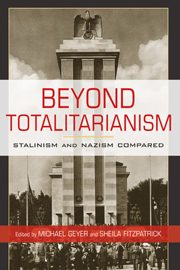Book contents
- Frontmatter
- Contents
- List of Contributors
- Acknowledgments
- Beyond Totalitarianism
- 1 Introduction
- PART I GOVERNANCE
- PART II VIOLENCE
- PART III SOCIALIZATION
- 6 Frameworks for Social Engineering
- 7 Energizing the Everyday
- 8 The New Man in Stalinist Russia and Nazi Germany
- PART IV ENTANGLEMENTS
- Works Cited
- Index
- References
8 - The New Man in Stalinist Russia and Nazi Germany
Published online by Cambridge University Press: 05 June 2012
- Frontmatter
- Contents
- List of Contributors
- Acknowledgments
- Beyond Totalitarianism
- 1 Introduction
- PART I GOVERNANCE
- PART II VIOLENCE
- PART III SOCIALIZATION
- 6 Frameworks for Social Engineering
- 7 Energizing the Everyday
- 8 The New Man in Stalinist Russia and Nazi Germany
- PART IV ENTANGLEMENTS
- Works Cited
- Index
- References
Summary
This essay explores anthropological ideals and practices in Stalinist Russia and Nazi Germany. Both regimes shared a fundamental commitment to producing a higher human type, and they both sponsored ambitious initiatives to transform, remake, and perfect their populations. But the ideologies that underwrote the “New Man” differed substantially. Whereas the Soviet system conceived of nothing less than the liberation of all humanity, the Nazis sought to create a master race in order to organize a new racial hierarchy in Europe. Yet both regimes cast their policies as answers and solutions to a perceived crisis of the contemporary world. Both identified the “bourgeois” world as an “old,” obsolescent order against which they deployed their visions of a New Man. As a result, both regimes stood in dialogue – sometimes implicitly, sometimes explicitly – with each other. Taken together, the visions and policies of these regimes represented a radical and total rejection of liberalism and its pursuit of the freedoms and rights of the individual. The New Man emerged as a constituent of an insistently collective subject, in the case of the Soviet Union, a classless, Communist society; in the case of the Third Reich, the racial union of Aryans. Although they were illiberal, both regimes were profoundly modern precisely because of their dedication to remaking and redefining the human species. Their project encompassed an alternative, illiberal modernity.
- Type
- Chapter
- Information
- Beyond TotalitarianismStalinism and Nazism Compared, pp. 302 - 342Publisher: Cambridge University PressPrint publication year: 2008
References
- 9
- Cited by

